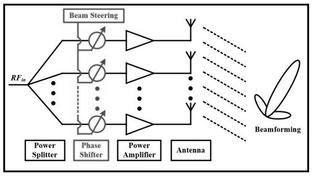Beamforming: Advantages and Disadvantages
Advertisement
This page explores the advantages and disadvantages of beamforming techniques. It outlines the benefits and drawbacks of beamforming and provides links to information on different beamforming methods.
What is Beamforming?
Introduction: Beamforming refers to the process of creating a focused beam of energy in a specific direction with the desired power level.
Beamforming allows for the manipulation of beam power and direction by adjusting the amplitude and phase of signals. Modern wireless systems utilize antenna arrays instead of single antennas in beamforming implementations.
Historically, mechanical rotation mechanisms were used to steer the antenna or antenna array, and separate systems were used for power amplification of the beams (i.e., antenna patterns).
The following are common types of beamforming techniques:
- Analog Beamforming: In this approach, precoding is applied to the analog signal after the Digital-to-Analog Converter (DAC) and before transmission over the air.
- Digital Beamforming: Here, precoding is applied to the digital signal or baseband signal before the DAC. After the DAC, the beamformed signal is transmitted over the air after Radio Frequency (RF) conversion.
- Hybrid Beamforming: This technique leverages the benefits of both analog and digital beamforming. Precoding is applied in both the analog and digital domains at radio frequencies (RF) and baseband frequencies, respectively.
 Image: Analog beamforming transmitter receiver architecture
Image: Analog beamforming transmitter receiver architecture
Beamforming equations used in analog type:
Wk = ak * ejsin(θk)
Wk = ak * cos(θk) + j* ak sin(θk)
Where:
- Wk represents the complex weight for the kth antenna in the array.
- ak is the relative amplitude of the weight.
- θk is the phase shift of the weight.
Weights are applied to analog signals in analog beamforming.
Benefits or Advantages of Beamforming
The following are the benefits and advantages of Beamforming:
- It increases the power of beams in the desired direction, allowing telecom cell towers or base stations to reach subscribers at a greater distance. This increases the supporting capacity of a cellular tower in terms of the number of subscribers.
- It can reduce the power of the beam for nearby subscribers, mitigating interference issues near the cell towers.
- As mentioned, it increases the Carrier-to-Noise (C/N) ratio of the signal, improving its resilience in noisy and attenuating channel environments. This expands the coverage capacity of the cell tower or base station.
- It is widely used with Multiple-Input Multiple-Output (MIMO) technology in modern wireless technologies like Mobile WiMAX (IEEE 802.16e), LTE, LTE-Advanced, and 5G due to its immunity to fading and interference.
Drawbacks or Disadvantages of Beamforming
The following are the disadvantages of Beamforming:
- Increased hardware complexity due to the use of multiple antennas and other hardware components.
- The beamforming system requires an advanced, high-processing Digital Signal Processing (DSP) chip to handle the mathematical algorithms involved in the design.
- The increased hardware resources and the use of advanced DSP chips result in a higher cost for the beamforming system compared to non-beamforming systems.
- Power consumption in beamforming systems is higher due to the increased use of resources, which can lead to faster battery drain.
Advertisement
 RF
RF



